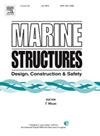Statistical characterization on slamming and green water impact onto a chemical tanker in extreme sea conditions
IF 5.1
2区 工程技术
Q1 ENGINEERING, CIVIL
引用次数: 0
Abstract
Characteristics of slamming and green water impact onto a chemical tanker in extreme waves are investigated using statistical analysis based on the model test data. Three extreme wave sequences which contain single real-world waves, the New Year wave, Three sisters waves and Yura wave are considered. The temporal variation of the wave surface elevation generated in the tests, along with the measured heave, pitch motions, and vertical bending moments amidships, are compared and analysed in relation to the probability of exceedance for the maxima and minima. The Weibull and Generalized Extreme Value (GEV) models are used to fit the peaks. Slamming pressures on various locations are discussed by comparing the time signals and analysing the peaks using the analytical distribution models for the three extreme waves. The green water column height and associated loading on the deck are presented and compared as well. Discussions are also provided for the results of slamming and green water impacts for the ship with a medium forward speed in the New Year waves. Statistical values including the largest peak, the mean of 1/10th, and 1/3rd highest value of the identified peaks on the pressures are calculated. In addition to the temporal variation of the slamming pressures, the statistical values of the peaks on 32 locations (26 on the bow and 6 on the stern) are calculated, providing insights on both the time variations and the distributions of the pressures.
极端海况下化学品船撞击和绿水冲击的统计特征
在模型试验数据的基础上,采用统计分析的方法研究了极端波浪条件下化学品船的撞击和绿水冲击特性。考虑了三种极端波序列,即现实世界的单波、新年波、三姐妹波和Yura波。试验中产生的波面高程随时间的变化,以及测量的升沉、俯仰运动和船中部的垂直弯矩,与最大值和最小值的超出概率进行了比较和分析。采用威布尔模型和广义极值(GEV)模型对峰值进行拟合。利用三种极端波的解析分布模型,通过对时间信号的比较和对峰值的分析,讨论了不同位置的撞击压力。给出了绿水柱高度和甲板上的相关荷载,并进行了比较。讨论了船舶在新年波中以中等前进速度撞击和绿水冲击的结果。计算压力峰值的最大值、平均值的1/10和最高值的1/3的统计值。除了撞击压力的时间变化外,还计算了32个位置(26个在船头,6个在船尾)峰值的统计值,从而提供了对时间变化和压力分布的见解。
本文章由计算机程序翻译,如有差异,请以英文原文为准。
求助全文
约1分钟内获得全文
求助全文
来源期刊

Marine Structures
工程技术-工程:海洋
CiteScore
8.70
自引率
7.70%
发文量
157
审稿时长
6.4 months
期刊介绍:
This journal aims to provide a medium for presentation and discussion of the latest developments in research, design, fabrication and in-service experience relating to marine structures, i.e., all structures of steel, concrete, light alloy or composite construction having an interface with the sea, including ships, fixed and mobile offshore platforms, submarine and submersibles, pipelines, subsea systems for shallow and deep ocean operations and coastal structures such as piers.
 求助内容:
求助内容: 应助结果提醒方式:
应助结果提醒方式:


